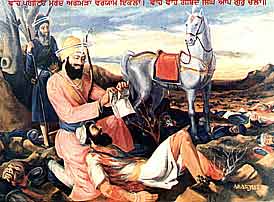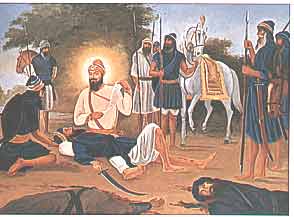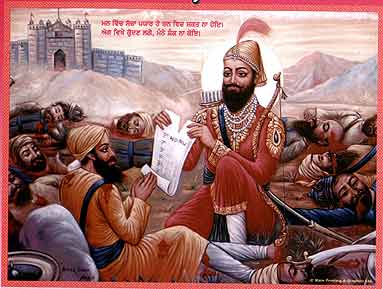
At the time of the siege on Anandpur, in late 1704, forty Sikhs, disheartened by the ravages of prolonged siege, had disclaimed Guru Gobind Singh ii. They gave him a baydava (written denial) saying, "Nan tun' sa-da- Guru atay na-n' asi tayray Sikh." (Neither are thou our Guru, nor we thy Sikhs.) When they returned to their families, their wives taunted them as traitors. Mal Bhago, a brave Sikh woman, charged them with cow-ardice and lack of faith. She inspired them to re-turn to the Guru's fold, and led them towards Khidrana to meet the Guru and seek his pardon. Many more joined her on the way.
Knowing that Wazir Khan was advancing to attack the Guru, Mai Bhago's group took up positions near Khidrana. To divert the enemy's at-tention towards their camp, they spread sheets on nearby bushes to give the impression of a large force. As soon as the Mughal forces came near, the Sikhs pounced on them. A fierce battle ensued; the Sikhs attacked with ferocity and smote the Mughals down before they, them-selves, fell in the battlefield. Mai Bhago fought with valour and redeemed the honour of the faithless forty Sikhs.
The dust raised by the Mughal forces and the war cries of the Sikhs alerted the Guru. He joined his Sikhs on the sand hill and shot arrows on the fast advancing enemy. When the enemy was halfway between Bhago's camp and the sand hill, the Guru mounted his horse and advanced to the actual scene of battle, personally leading a vehement assault on the enemy. The enemy could not stand a sudden attack by another Sikh contingent. They were already fatigued by the long night march and lack of drinking water in the hot weather of May in Panjab. The enemy sustained heavy losses and withdrew, leaving their dead on the battlefield.

The Guru proceeded across the battlefield to find out who had provided such timely assis-tance. He found Mahan Singh, one of his Sikhs who had disclaimed him at Anandpur, still con-scious. The Guru took him in his lap, wiped his face, and with tears of joy in his eyes, said: "Ask whatever you may and I shall grant." The devo-tee, his breath choked with emotion, sobbed, "Master, if you are in mercy, forgive me and my companions for our earlier betrayal at Anandpur. Pray, tear up the baydava and restore our relationship of the Sikh and the Guru." The Guru tore the baydava and blessed him, "You have redeeme4 yourself both here and in the hereafter." The' forty deserters who lay dead on the battlefield were blessed by Guru Saheb as chalee muktay (forty liberated ones). There is a grand gurdwara built in the battle area, known as Gurdwara Muktsar (the pool of salvation).
(Article courtesy Dr. Santokh Singh, "The Guru's Word"
